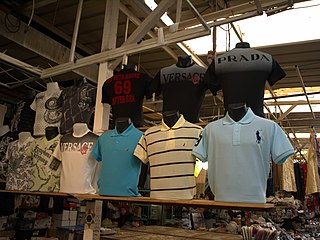Related Research Articles

Franchising is based on a marketing concept which can be adopted by an organization as a strategy for business expansion. Where implemented, a franchisor licenses some or all of its know-how, procedures, intellectual property, use of its business model, brand, and rights to sell its branded products and services to a franchisee. In return, the franchisee pays certain fees and agrees to comply with certain obligations, typically set out in a franchise agreement.

Marketing is the act of satisfying and retaining customers. It is one of the primary components of business management and commerce.

Telemarketing is a method of direct marketing in which a salesperson solicits prospective customers to buy products, subscriptions or services, either over the phone or through a subsequent face to face or web conferencing appointment scheduled during the call. Telemarketing can also include recorded sales pitches programmed to be played over the phone via automatic dialing.

To counterfeit means to imitate something authentic, with the intent to steal, destroy, or replace the original, for use in illegal transactions, or otherwise to deceive individuals into believing that the fake is of equal or greater value than the real thing. Counterfeit products are fakes or unauthorized replicas of the real product. Counterfeit products are often produced with the intent to take advantage of the superior value of the imitated product. The word counterfeit frequently describes both the forgeries of currency and documents as well as the imitations of items such as clothing, handbags, shoes, pharmaceuticals, automobile parts, unapproved aircraft parts, watches, electronics and electronic parts, software, works of art, toys, and movies.

Rebranding is a marketing strategy in which a new name, term, symbol, design, concept or combination thereof is created for an established brand with the intention of developing a new, differentiated identity in the minds of consumers, investors, competitors, and other stakeholders. Often, this involves radical changes to a brand's logo, name, legal names, image, marketing strategy, and advertising themes. Such changes typically aim to reposition the brand/company, occasionally to distance itself from negative connotations of the previous branding, or to move the brand upmarket; they may also communicate a new message a new board of directors wishes to communicate.
Reputation management, originally a public relations term, refers to the influencing, controlling, enhancing, or concealing of an individual's or group's reputation. The growth of the internet and social media led to growth of reputation management companies, with search results as a core part of a client's reputation. Online reputation management, sometimes abbreviated as ORM, focuses on the management of product and service search engine results.
A parallel import is a non-counterfeit product imported from another country without the permission of the intellectual property owner. Parallel imports are often referred to as grey product and are implicated in issues of international trade, and intellectual property.

Country of origin (CO) represents the country or countries of manufacture, production, design, or brand origin where an article or product comes from. For multinational brands, CO may include multiple countries within the value-creation process.
Nation branding aims to measure, build and manage the reputation of countries. In the book Diplomacy in a Globalizing World: Theories and Practices, the authors define nation branding as "the application of corporate marketing concepts and techniques to countries, in the interests of enhancing their reputation in international relations." Many nations try to make brands in order to build relationships between different actors that are not restricted to nations. It extends to public and private sectors in a nation and helps with nationalism. States also want to participate in multilateral projects. Some approaches applied, such as an increasing importance on the symbolic value of products, have led countries to emphasize their distinctive characteristics. The branding and image of a nation-state "and the successful transference of this image to its exports - is just as important as what they actually produce and sell." This is also referred to as country-of-origin effect.

Brand piracy is the act of naming a product in a manner which can result in confusion with other better known brands. According to author Robert Tönnis The term brand piracy is unauthorized usage of protected brand names, labels, designs or description of trade. Annika Kristin states "brand Piracy is considered to be the premeditated use of registered trademark, its name, its tradename or the packaging and presentation of its products". It is a major loss to MNEs around the world as it causes a loss of revenue and image of the brand.
Marketing effectiveness is the measure of how effective a given marketer's go to market strategy is toward meeting the goal of maximizing their spending to achieve positive results in both the short- and long-term. It is also related to marketing ROI and return on marketing investment (ROMI). In today's competitive business environment, effective marketing strategies play a pivotal role in promoting products or services to target audiences. The advent of digital platforms has further intensified competition among businesses, making it imperative for companies to employ innovative and impactful marketing techniques. This essay examines how various types of advertising methods can be utilized effectively to reach out to potential consumers
The following outline is provided as an overview of and topical guide to marketing:
Comparative advertising, or combative advertising, is an advertisement in which a particular product, or service, specifically mentions a competitor by name for the express purpose of showing why the competitor is inferior to the product naming it. Also referred to as "knocking copy", it is loosely defined as advertising where "the advertised brand is explicitly compared with one or more competing brands and the comparison is obvious to the audience". An advertising war is said to be occurring when competing products or services exchange comparative or combative advertisements mentioning each other.

A trademark is a type of intellectual property consisting of a recognizable sign, design, or expression that identifies a product or service from a particular source and distinguishes it from others. A trademark owner can be an individual, business organization, or any legal entity. A trademark may be located on a package, a label, a voucher, or on the product itself. Trademarks used to identify services are sometimes called service marks.

A brand is a name, term, design, symbol or any other feature that distinguishes one seller's good or service from those of other sellers. Brands are used in business, marketing, and advertising for recognition and, importantly, to create and store value as brand equity for the object identified, to the benefit of the brand's customers, its owners and shareholders. Brand names are sometimes distinguished from generic or store brands.
Counterfeit consumer goods—or counterfeit, fraudulent, and suspect items (CFSI)—are goods, often of inferior quality, made or sold under another's brand name without the brand owner's authorization. The colloquial terms knockoff or dupe (duplicate) are often used interchangeably with counterfeit, although their legal meanings are not identical.

Trademark infringement is a violation of the exclusive rights attached to a trademark without the authorization of the trademark owner or any licensees. Infringement may occur when one party, the "infringer", uses a trademark which is identical or confusingly similar to a trademark owned by another party, especially in relation to products or services which are identical or similar to the products or services which the registration covers. An owner of a trademark may commence civil legal proceedings against a party which infringes its registered trademark. In the United States, the Trademark Counterfeiting Act of 1984 criminalized the intentional trade in counterfeit goods and services.
Sustainability brands are brands that undertake sustainable practises in the workings of their business and champion them.
In Canada, passing off is both a common law tort and a statutory cause of action under the Canadian Trade-marks Act referring to the deceptive representation or marketing of goods or services by competitors in a manner that confuses consumers. The law of passing off protects the goodwill of businesses by preventing competitors from passing off their goods as those of another.
Legal fake is a phenomenon in the fashion industry wherein a third company precedes the original brand company in the registration of the trademark, running its own business, from production to sales, in another country. By exploiting the products, creativity, marketing, and advertising strategies of the original brand, the company misleads consumers, who are not aware that the goods are fake goods. Thus, its typical traits lay upon the question of intellectual property, trademark registration laws among different countries, advertising strategies, and consumer behaviour.
References
- ↑ Affärsvärlden: Renommésnyltning och vilseledande påståenden i marknadsföring av spel
- 1 2 Samelin, Jessica (2016-08-29). "Reputation parasitism: functioning concept or failed attempt?". Lexology. Retrieved 2024-04-24.
- ↑ MD 2005:13
- ↑ SMH: Versace puts stopper in local wine of same name
- ↑ Busby, J.S. (2019). "The co-evolution of competition and parasitism in the resource-based view: A risk model of product counterfeiting". European Journal of Operational Research. 276 (1): 300–313. doi:10.1016/j.ejor.2018.12.039.
